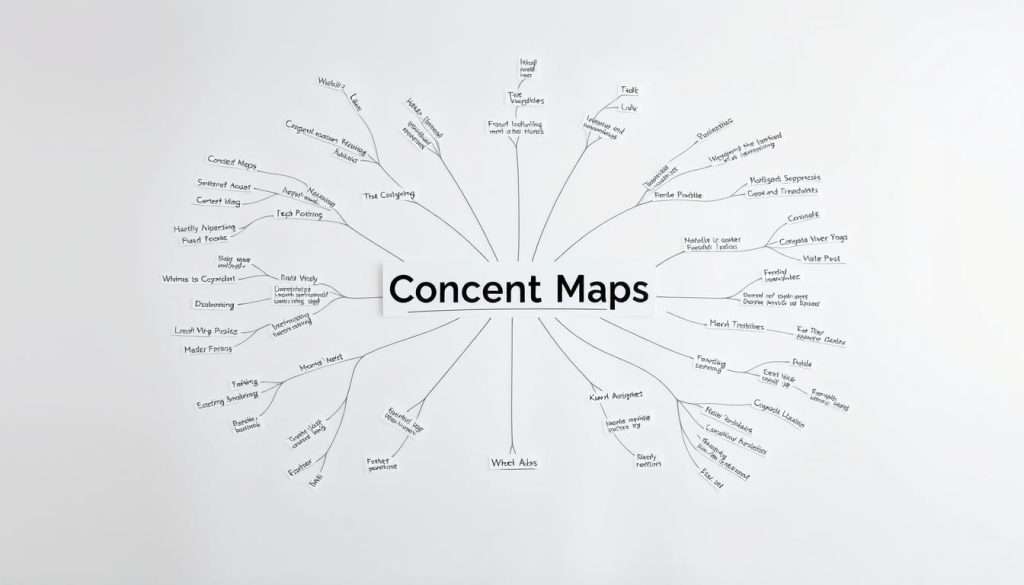Are you tired of studying with dull, linear notes? Visual learning aids like concept maps can change how you learn! They help you organize your thoughts better and remember information more easily.
A concept map is a great tool for seeing how ideas are connected. It lets you map out your knowledge, showing how different pieces fit together. This makes studying for exams or working on big projects much easier.
Key Takeaways
- Concept maps help organize thoughts and retain information.
- Visual learning aids improve knowledge retention.
- Using concept maps can enhance your learning experience.
- Concept maps help visualize relationships between ideas.
- They are a useful tool for exam preparation and project work.
What Are Concept Maps?
Concept maps are more than just diagrams. They visually represent knowledge and the connections between ideas. They help us organize and link concepts, making complex information easier to grasp.
The Science Behind Visual Learning
Our brains love visual stuff, and concept maps use images, colors, and layout to share meaning. This visual learning method is powerful. It lets us see the whole picture and how all the pieces fit together.
Concept Maps vs. Mind Maps: Understanding the Difference
Concept maps and mind maps are both visual tools for organizing info. But they have different uses. Let’s look at the main differences:
Structural Differences
Concept maps follow a structured path, with labeled arrows showing connections. Mind maps, however, start with a central idea and spread out in a more flexible way.
Purpose and Applications
Concept maps are great in schools to help students grasp complex topics. Mind maps are more flexible. They’re good for brainstorming, jotting down notes, and planning projects.
| Characteristics | Concept Maps | Mind Maps |
|---|---|---|
| Structure | More structured, with labeled arrows | Less structured, branching out from a central idea |
| Purpose | Understanding complex topics and relationships | Brainstorming, note-taking, project planning |
| Applications | Educational settings, research, and analysis | Personal organization, creativity, and planning |
The Power of Concept Maps in Learning
Concept maps change complex info into easy-to-understand visuals. This makes learning and remembering easier.
Cognitive Benefits of Visual Organization
Concept maps boost our brain power. They help us understand and think better. With concept mapping tools, we can see complex info clearly.
How Concept Maps Enhance Memory Retention
Studies prove that visual aids like concept maps help us remember better. Interactive concept mapping makes learning fun and helps us remember more. It works by using both sides of our brain.
Research-Backed Advantages for Students
Many studies show that concept maps help students think better and learn more. By using concept map software, students can make interactive maps. This makes learning more fun and effective.
| Benefits | Description | Impact |
|---|---|---|
| Improved Comprehension | Visual representation of complex information | Better understanding of material |
| Enhanced Critical Thinking | Analysis and organization of information | Improved problem-solving skills |
| Better Memory Retention | Engaging visual aids | Improved recall and retention |
Key Elements of Effective Concept Maps
To get the most out of concept maps, knowing their key parts is crucial. Good concept maps have important elements that boost your learning. These elements work together to make learning better.
Nodes and Propositions
At the core of every concept map are nodes and propositions. Nodes are ideas or concepts. Propositions are the links between these nodes. For example, in a map about climate change, “global warming” might link to “rising sea levels” with the proposition “causes.”
Hierarchical Structure
A good concept map has a hierarchical structure. It starts with broad ideas at the top and gets more specific as you go down. This makes it easier to move from big topics to smaller details, helping you grasp complex info.
Cross-Links and Relationships
Cross-links are key too. They show how different parts of the map are connected. They help you see how unrelated ideas are linked, deepening your understanding.
Creating Meaningful Connections
To make connections that matter, look for real ties between ideas. Ask yourself, “How does this idea relate to that one?” or “What causes this?” This way, you’ll get a deeper grasp of the topic and make a more useful concept map.
Step-by-Step Guide to Creating Your First Concept Map
Let’s start making your first concept map. It’s a great tool for students and anyone who loves to learn. It helps you see your ideas, organize them, and remember things better.
Identifying Your Central Concept
The first thing to do is pick your main idea. This could be something you’re studying, a project, or a problem you’re tackling. Make sure your main idea is clear and simple. It’s the base of your map.
Brainstorming Related Ideas
After picking your main idea, think of related ideas. Don’t hold back and come up with as many as you can. Use words, phrases, or short sentences to jot them down.
Establishing Connections and Hierarchies
Now, connect your ideas and organize them. Group similar ideas together and show how they’re related. Use arrows and lines to link your ideas and make your map.
Refining Your Map
Keep working on your map by rearranging ideas and adding new connections. Make sure it’s clear and complete by asking yourself a few questions:
Testing for Clarity and Completeness
- Is my central concept clear and concise?
- Are my ideas well-organized and easy to follow?
- Have I included all relevant information?
By following these steps and improving your map, you’ll have a powerful tool. It will help you learn better and reach your goals.
Advanced Concept Mapping Techniques
Advanced concept mapping techniques can reveal new insights and connections. They help you see things you might have missed before. It’s not just about making a map; it’s about growing and learning.
Cross-Disciplinary Mapping
Cross-disciplinary mapping combines ideas from different subjects into one map. It shows how various areas are connected, giving a deeper understanding. This way, you see the big picture of complex topics.
Collaborative Concept Mapping
Collaborative mapping means working with others on a map. It’s great for group projects or study groups. It helps everyone stay in sync. Using concept mapping tools and concept map software makes it easier.
Dynamic and Evolving Maps
Concept maps should change as you learn more. Updating your maps regularly is key. It shows new insights and connections.
Updating Maps as Knowledge Grows
When you learn something new, update your map. This solidifies your knowledge and uncovers new patterns. Interactive concept mapping makes this process fun and effective.
Top Concept Mapping Tools and Software
Choosing the right tools for creating concept maps is crucial. There are many options available, so you can pick the one that suits you best.
Free Online Options
For those on a budget or just starting, free online tools are a good start. They offer many features without the cost.
Web-Based Solutions
Web-based tools like Coggle and Lucidchart are easy to use. They also have features for working together. You can easily make and share maps.
Open-Source Alternatives
Open-source tools like XMind give you more control. They have advanced features and customization options. They’re perfect for those who want detailed maps.
Premium Software Solutions
Premium tools are for professionals and serious learners. They have advanced features and work well with other tools. MindMeister is a great example.
As “The right tool can elevate your concept mapping experience, making it more efficient and effective.”
Mobile Apps for On-the-Go Mapping
Mobile apps let you make maps anywhere, anytime. SimpleMind is one app that works well on all devices. It’s great for brainstorming and organizing on the move.

Whether you’re a student, teacher, or professional, there’s a tool for you. Using these tools can improve your learning and work.
“Concept mapping is a powerful tool for learning and organization. With the right software, you can unlock its full potential.”
Concept Map in Learning: Practical Applications
Concept maps are useful in many ways, from taking notes to planning projects. They help you organize information visually. This makes complex ideas easier to grasp and remember.
Note-Taking and Study Sessions
Concept maps shine in note-taking and studying. They let you organize information visually. This makes it simpler to review and remember important points. By mapping your notes, you can see how different ideas connect.
Project Planning and Research
In project planning and research, concept maps are a big help. They let you organize your thoughts and ideas. A visual map of your project shows key tasks and timelines. It ensures you don’t miss any important parts.
Problem-Solving and Critical Thinking
Concept maps also boost problem-solving and critical thinking. They help you map out a problem. This way, you can spot key issues and explore solutions.
Exam Preparation Strategies
Lastly, concept maps are great for exam prep. They help you reinforce your understanding of key concepts. This way, you can see where to focus your studying.
Educational Concept Mapping Across Subjects
Concept maps are visual learning aids that help students connect new information to what they already know. They are useful in many subjects, from science to literature.
STEM Applications
In STEM fields, concept maps show how different concepts are related. For example, in biology, they help students understand how living things are classified. In physics, they show how energy moves.
Humanities and Social Sciences
In humanities and social sciences, concept maps help students see the big picture. They show how historical events, literary movements, or sociological theories are connected.
Language Learning and Vocabulary Building
For language learners, concept maps are great for building vocabulary. By mapping out word associations, learners can remember new words better and understand their meanings.
| Subject Area | Concept Map Application | Learning Benefits |
|---|---|---|
| STEM | Illustrating complex concepts and relationships | Improved understanding of complex systems |
| Humanities and Social Sciences | Contextualizing historical events and literary movements | Enhanced contextual understanding |
| Language Learning | Vocabulary building through word associations | Better retention of new vocabulary |
Interactive Concept Mapping for Enhanced Learning
Interactive concept mapping is more than a method; it’s a way to dive deeper into learning. With digital tools and multimedia, learners can make maps that help them understand and remember better.
Digital vs. Handwritten Maps
Digital concept maps beat traditional handwritten ones in many ways. Digital tools make it easy to edit, work together in real-time, and add multimedia like images and videos. This mix of visuals and interactivity makes learning more fun and effective.
Incorporating Multimedia Elements
Adding multimedia to concept maps makes hard information easier to grasp. For example, a video or interactive simulation can explain tricky topics clearly. By combining text, images, and multimedia, learners can create a detailed and engaging information landscape that suits different learning styles.
Sharing and Collaborating on Maps
Digital concept mapping shines when it comes to sharing and working together. Tools like collaborative software let many users work on a map at the same time. This teamwork spirit makes learning more enjoyable and helps in group projects and study groups.

Concept Map Examples That Drive Success
Concept maps help organize information, leading to success in many areas. They are useful for students, professionals, and anyone looking to learn more. These maps are a powerful tool for reaching your goals.
Academic Case Studies
Concept maps boost learning in schools. Students use them to organize notes, study for exams, or work on projects. This visual method makes complex topics easier to understand and remember.
Professional Development Applications
In work settings, concept maps aid in planning projects, brainstorming, and solving problems. They help teams see the project’s scope, key tasks, and timelines. This leads to better project management and teamwork.
Personal Learning Journey Maps
People can track their learning with concept maps. By mapping their progress, learners can see what they need to work on. This helps them adjust their learning plans.
Before and After Learning Comparisons
Creating a concept map before and after learning is very helpful. This before-and-after comparison shows how much you’ve learned and grown.
These examples show how versatile and effective concept maps are. By using them, you can improve your learning and reach your goals faster.
Overcoming Common Challenges in Concept Mapping
Concept mapping is a great tool, but it comes with its own set of challenges. You might face issues as you start making your maps. But don’t worry, we’ve got you covered!
Dealing with Complex Subjects
Complex subjects can be overwhelming. To tackle this, break down the topic into smaller, manageable chunks. Focus on one aspect at a time. Use your concept map to see how these pieces fit together.
This approach makes the task less daunting and more achievable.
Managing Large Maps Effectively
As your map grows, it can get cluttered and hard to navigate. To manage large maps, consider using concept map software. This software lets you zoom in and out, and collapse or expand sections as needed.
You can also use different colors or shapes to categorize related ideas.
Avoiding Common Mistakes
One common mistake is making your map too complicated with too many details. To avoid this, keep your map concise and focused on the key concepts. Regularly review and refine your map to ensure it remains clear and effective.
When to Split Into Multiple Maps
Sometimes, a single map can become too large or complex. In such cases, consider dividing it into multiple maps. Each map can focus on a specific aspect of the topic.
This approach helps you maintain clarity and makes your maps more manageable.
By being aware of these common challenges and using the right concept mapping techniques and visual learning aids, you can create effective concept maps. These maps will enhance your learning experience.
Conclusion: Transform Your Learning Journey with Concept Maps
Concept maps can change how you learn and keep information. They help you organize your thoughts and ideas. This makes your learning better, improving your thinking and creativity.
Students, using concept maps can really help you. They’re great for notes, planning projects, or studying for exams. They connect different ideas, helping you understand more deeply.
Try using concept maps to improve your learning. Start making your own today. See how this simple method can change your learning journey.

